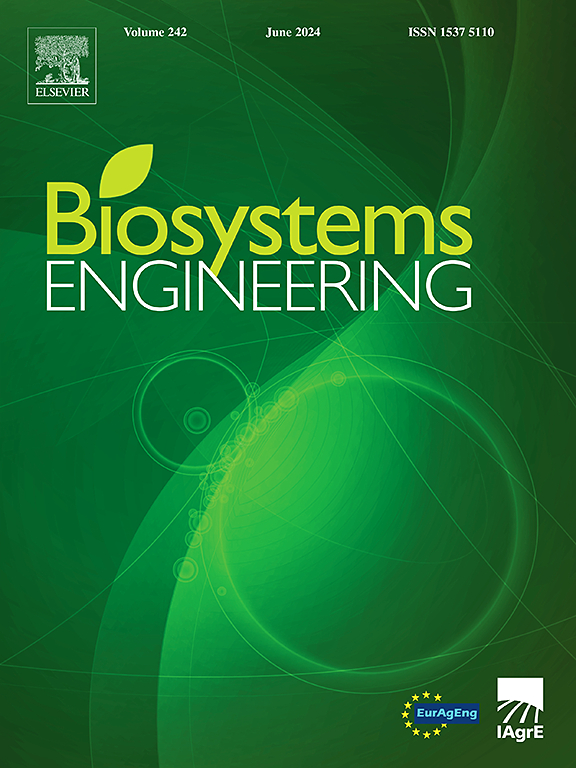柑桔果实直径的单目相机估算
IF 5.3
1区 农林科学
Q1 AGRICULTURAL ENGINEERING
引用次数: 0
摘要
柑橘果实大小的准确和有效的测量是必不可少的管理树形和估计产量。传统的手动方法是可靠的,但高度劳动密集型,而现有的机器视觉解决方案通常需要专门的设置(例如,距离校准或3D传感器)。在这项研究中,提出了一种低成本,基于单眼的框架,以成熟和健康的叶子作为自然参考对象,无需手动标记或复杂的相机参数校准。通过编译多个柑橘品种的离线叶片大小分布,该方法使用每张图像中最大的近正面叶片自动将水果像素转换为现实世界的直径。此外,该工作将可变形卷积(dcnv2)和shuffle attention (SA)集成到YOLOv8检测器中,以改善遮挡处理,确保即使水果部分被树叶遮挡也能进行鲁棒检测。对3个不同柑橘品种的广泛验证表明,叶片大小变异对直径估计的相对误差小于3.2%,而整体方法的准确率为93.14%,R2 = 0.76。主要贡献包括:(1)利用固有果园元素(树叶)作为参考的新颖单目技术,(2)先进的检测模块来解决部分遮挡,(3)跨品种验证展示一致的性能,以及(4)适合实际果园应用的快速,用户友好的工作流程。未来的工作将探索多帧或多视图策略,以进一步改进重遮挡下的直径测量。本文章由计算机程序翻译,如有差异,请以英文原文为准。
Citrus fruit diameter estimation in the field using monocular camera
Accurate and efficient measurement of citrus fruit size is essential for managing tree form and estimating yields. Conventional manual methods are reliable but highly labour-intensive, while existing machine vision solutions often require specialised setups (e.g., distance calibration or 3D sensors). In this study, a low-cost, monocular-based framework that uses mature and healthy leaves as natural reference objects was proposed, eliminating the need for manual markers or complex camera parameter calibration. By compiling an offline leaf-size distribution from multiple citrus varieties, this method automatically converts fruit pixels to real-world diameters using the largest near-frontal leaf in each image. Further, the work integrates the deformable convolution (DNCv2) and shuffle attention (SA) into a YOLOv8 detector to improve occlusion handling, ensuring robust detection even when fruits are partially obscured by foliage. Extensive validation on three different citrus cultivars shows that leaf-size variability contributes less than 3.2% relative error in diameter estimation, while the overall approach achieves 93.14% accuracy and R2 = 0.76. Key contributions include: (1) a novel monocular technique leveraging inherent orchard elements (leaves) as references, (2) advanced detection modules to tackle partial occlusion, (3) cross-variety validation demonstrating consistent performance, and (4) a fast, user-friendly workflow suitable for real-world orchard applications. Future work will explore multi-frame or multi-view strategies to further refine diameter measurement under heavy occlusion.
求助全文
通过发布文献求助,成功后即可免费获取论文全文。
去求助
来源期刊

Biosystems Engineering
农林科学-农业工程
CiteScore
10.60
自引率
7.80%
发文量
239
审稿时长
53 days
期刊介绍:
Biosystems Engineering publishes research in engineering and the physical sciences that represent advances in understanding or modelling of the performance of biological systems for sustainable developments in land use and the environment, agriculture and amenity, bioproduction processes and the food chain. The subject matter of the journal reflects the wide range and interdisciplinary nature of research in engineering for biological systems.
 求助内容:
求助内容: 应助结果提醒方式:
应助结果提醒方式:


